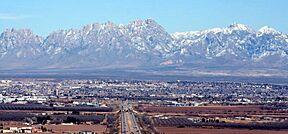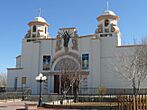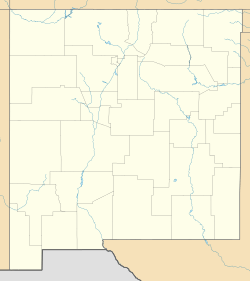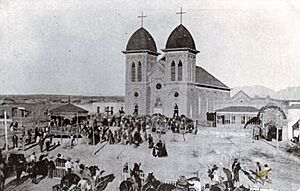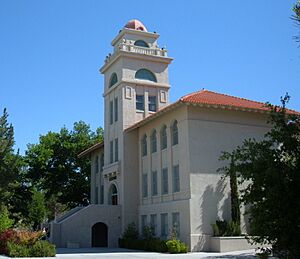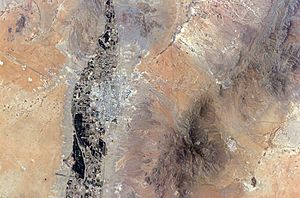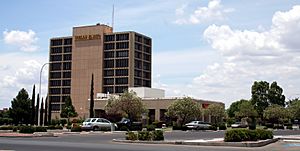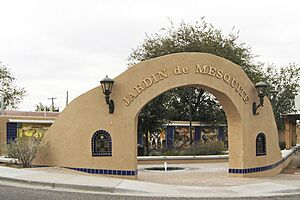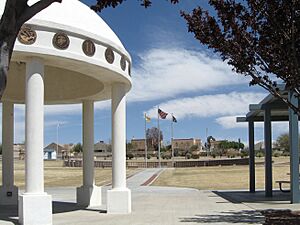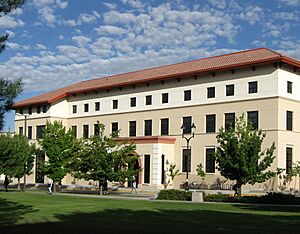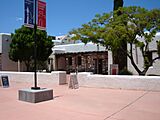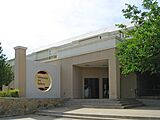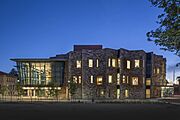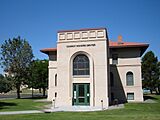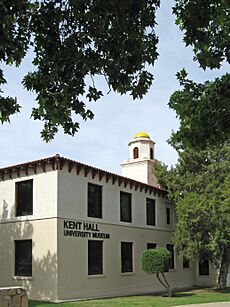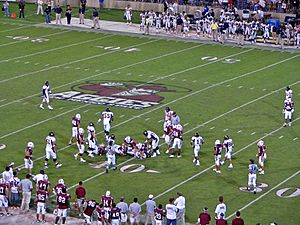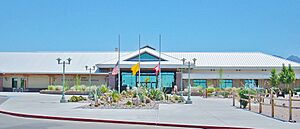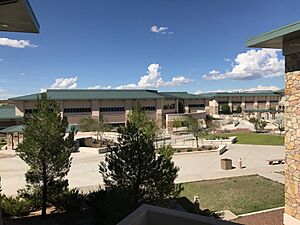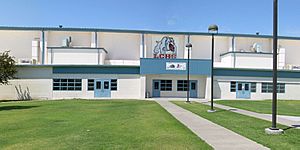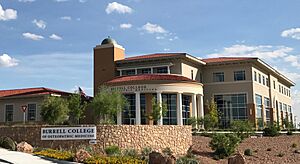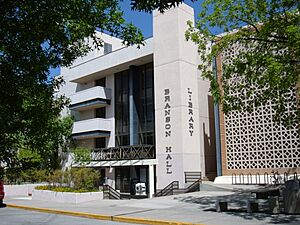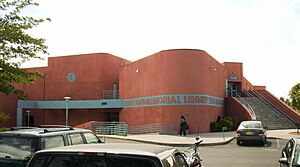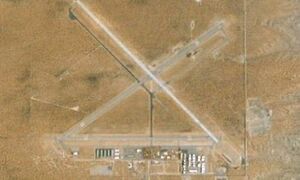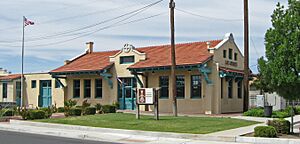Las Cruces, New Mexico facts for kids
Quick facts for kids
Las Cruces, New Mexico
|
|||
|---|---|---|---|
|
|
|||
|
|||
| Nickname(s):
The City of the Crosses
|
|||
| Motto(s):
Mountains of Opportunity
|
|||
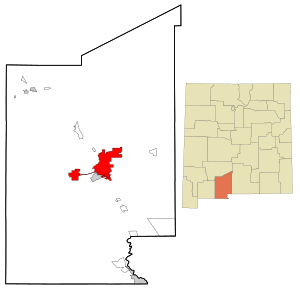
Location of Las Cruces within Doña Ana County and New Mexico
|
|||
| Country | |||
| State | |||
| County | Doña Ana | ||
| Founded | 1849 | ||
| Incorporated | 1907 | ||
| Government | |||
| • Type | Council–manager | ||
| Area | |||
| • City | 77.03 sq mi (199.51 km2) | ||
| • Land | 76.93 sq mi (199.26 km2) | ||
| • Water | 0.10 sq mi (0.25 km2) | ||
| Elevation | 3,901 ft (1,189 m) | ||
| Population
(2020)
|
|||
| • City | 111,385 | ||
| • Density | 1,447.82/sq mi (559.00/km2) | ||
| • Metro | 217,552 (US: 202th) | ||
| Demonym(s) | Las Crucen | ||
| Time zone | UTC−07:00 (Mountain) | ||
| • Summer (DST) | UTC−06:00 (DST) | ||
| ZIP Codes |
88001, 88003-88007, 88011-88013
|
||
| Area code(s) | 575 | ||
| FIPS code | 35-39380 | ||
| GNIS feature ID | 2411629 | ||
Las Cruces is the second-largest city in New Mexico. It is also the main city of Doña Ana County. In 2020, about 111,385 people lived there. This makes Las Cruces the biggest city in southern New Mexico. The larger area around Las Cruces has over 213,000 people.
Las Cruces is important for the economy and geography of the Mesilla Valley. This is a farming area along the Rio Grande river. The city is home to New Mexico State University (NMSU). This is New Mexico's only land-grant university. Many people in Las Cruces work for the government at places like White Sands Test Facility and White Sands Missile Range.
The Organ Mountains are about 10 miles (16 km) east of the city. They are a major part of the landscape. Other mountains nearby include the Doña Ana Mountains and Robledo Mountains. Las Cruces is about 225 miles (362 km) south of Albuquerque. It is 42 miles (68 km) northwest of El Paso, Texas. The city is also 41 miles (66 km) north of the Mexican border.
Spaceport America has offices in Las Cruces. This spaceport is about 55 miles (89 km) north of the city. It has launched several successful sub-orbital flights with people on board. Las Cruces is also the main office for Virgin Galactic. This is the first company to offer flights into space for tourists.
Contents
History of Las Cruces
The area near Las Cruces was a battlefield during the Mexican–American War. The Battle of El Bracito happened here on Christmas Day in 1846. The city of Las Cruces was started in 1849. This was after the US Army surveyed the land. The land became part of the New Mexico Territory after the Treaty of Guadalupe Hidalgo in 1848. This treaty ended the Mexican-American War. The town was named "Las Cruces," which means "the crosses." It was named after three crosses that were once north of the town.
At first, a nearby town called Mesilla was bigger. It had more than 2,000 people in 1860. Las Cruces was smaller. When the Atchison, Topeka, and Santa Fe Railway wanted to build tracks, Mesilla did not want to sell land. But people in Las Cruces gave land for the tracks and a train station. The first train arrived in Las Cruces in 1881. The city grew to 2,300 people in the 1880s. Las Cruces officially became a town in 1907.

New Mexico State University was founded in 1888. It has grown as Las Cruces has grown. The city's growth is also due to the university and government jobs. Many retired people have also moved to Las Cruces.
The creation of White Sands Missile Range in 1944 and White Sands Test Facility in 1963 helped the city grow a lot. These places are close to Las Cruces and offer many good government jobs.
In the 1960s, Las Cruces started a big project to update its downtown. They wanted to make it a modern city center. As part of this, an old church, St. Genevieve's Catholic Church, was taken down. This made space for a walking area downtown. Later, this walking area was changed back into a regular street for cars.
Geography and Landscape
Las Cruces is about 3,908 feet (1,191 meters) above sea level. The city covers about 76.6 square miles (198.5 square kilometers). Most of this area is land, with a small amount of water.
Las Cruces is in the middle of the Organ Caldera. The Doña Ana Mountains are to the north, and the Organ Mountains are to the east. These mountains were formed by a large volcanic eruption 32 million years ago.
Doña Ana County is part of the Chihuahuan Desert. The plants around Las Cruces are typical of this desert. You can see creosote bush, soaptree, tarbush, and different desert grasses.
The Rio Grande river flows west of Las Cruces. It provides water for farming in the Mesilla Valley. However, due to dry conditions, the river often has very little water.

Before farming and ranching, the valley had desert plants like tornillo and catclaw acacia. Desert grasslands are found between Las Cruces and the nearby Organ and Robledo Mountains. These areas have grasses, shrubs, and cacti.
The dry streambeds, called arroyos, often carry water after heavy thunderstorms. These arroyos have small trees and are pathways for wildlife between the city and the deserts or mountains.
City Layout and Downtown
Las Cruces does not have one main business area like some cities its size. This is because a project in the 1960s changed much of the old downtown. Many big stores and restaurants are now on the fast-growing east side of the city. The main shopping mall is also in this area.
However, the historic downtown is around Main Street. A part of Main Street was closed to cars in 1973 to create a walking area. This downtown area now has a large farmers market on Wednesdays and Saturdays. Here, you can buy food and crafts from local farmers and artists. The downtown also has museums, businesses, restaurants, churches, art galleries, and theaters.
In 2012, Main Street was reopened to cars. In 2013, the mayor announced a new park behind the Las Cruces Dam. This park has trails through wetlands and is a home for migratory birds. It is also a popular spot for recreation.
Climate and Weather
Las Cruces has a cool desert climate. Winters can be cold and windy, but also have warm, sunny days. Light freezes happen about 69 nights a year. Spring months can be windy, sometimes causing dust storms. Summers start very hot, with temperatures often over 100°F (38°C). Later in the summer, there is more humidity and frequent afternoon thunderstorms.
Rainfall is very low from October to June. Most winter rain is light, and some light snow falls most winters. Summer rain often comes from heavy thunderstorms, especially during the late summer monsoon season.
The lowest temperature ever recorded in Las Cruces was -10°F (-23°C) in 1962. The highest was 110°F (43°C) in 1994. The wettest year was 1941, and the driest was 1970.
| Climate data for Las Cruces, New Mexico, 1991–2020 normals, extremes 1892–present | |||||||||||||
|---|---|---|---|---|---|---|---|---|---|---|---|---|---|
| Month | Jan | Feb | Mar | Apr | May | Jun | Jul | Aug | Sep | Oct | Nov | Dec | Year |
| Record high °F (°C) | 78 (26) |
86 (30) |
90 (32) |
96 (36) |
104 (40) |
110 (43) |
109 (43) |
109 (43) |
103 (39) |
95 (35) |
87 (31) |
78 (26) |
110 (43) |
| Mean maximum °F (°C) | 70.2 (21.2) |
76.1 (24.5) |
83.7 (28.7) |
89.1 (31.7) |
97.1 (36.2) |
103.8 (39.9) |
103.5 (39.7) |
100.1 (37.8) |
96.9 (36.1) |
90.7 (32.6) |
79.6 (26.4) |
71.1 (21.7) |
105.0 (40.6) |
| Mean daily maximum °F (°C) | 58.9 (14.9) |
64.1 (17.8) |
71.3 (21.8) |
78.5 (25.8) |
87.1 (30.6) |
96.2 (35.7) |
95.6 (35.3) |
93.6 (34.2) |
88.4 (31.3) |
79.6 (26.4) |
67.9 (19.9) |
58.1 (14.5) |
78.3 (25.7) |
| Daily mean °F (°C) | 44.2 (6.8) |
48.8 (9.3) |
55.2 (12.9) |
62.1 (16.7) |
70.6 (21.4) |
80.0 (26.7) |
82.4 (28.0) |
80.6 (27.0) |
74.8 (23.8) |
64.0 (17.8) |
52.2 (11.2) |
43.9 (6.6) |
63.2 (17.3) |
| Mean daily minimum °F (°C) | 29.6 (−1.3) |
33.5 (0.8) |
39.2 (4.0) |
45.7 (7.6) |
54.2 (12.3) |
63.7 (17.6) |
69.1 (20.6) |
67.7 (19.8) |
61.1 (16.2) |
48.3 (9.1) |
36.6 (2.6) |
29.7 (−1.3) |
48.2 (9.0) |
| Mean minimum °F (°C) | 20.8 (−6.2) |
23.3 (−4.8) |
29.0 (−1.7) |
35.9 (2.2) |
43.7 (6.5) |
55.5 (13.1) |
63.5 (17.5) |
62.7 (17.1) |
51.8 (11.0) |
36.3 (2.4) |
25.3 (−3.7) |
19.9 (−6.7) |
17.7 (−7.9) |
| Record low °F (°C) | −10 (−23) |
−5 (−21) |
8 (−13) |
20 (−7) |
27 (−3) |
35 (2) |
42 (6) |
44 (7) |
30 (−1) |
20 (−7) |
−4 (−20) |
−1 (−18) |
−10 (−23) |
| Average precipitation inches (mm) | 0.48 (12) |
0.36 (9.1) |
0.26 (6.6) |
0.22 (5.6) |
0.38 (9.7) |
0.65 (17) |
1.77 (45) |
1.73 (44) |
1.41 (36) |
0.82 (21) |
0.42 (11) |
0.64 (16) |
9.14 (233) |
| Average snowfall inches (cm) | 0.4 (1.0) |
0.1 (0.25) |
0.0 (0.0) |
0.0 (0.0) |
0.0 (0.0) |
0.0 (0.0) |
0.0 (0.0) |
0.0 (0.0) |
0.0 (0.0) |
0.0 (0.0) |
0.1 (0.25) |
0.4 (1.0) |
1.0 (2.5) |
| Average precipitation days (≥ 0.01 in) | 3.3 | 2.5 | 2.0 | 1.6 | 2.1 | 3.2 | 8.9 | 8.4 | 5.2 | 4.0 | 2.6 | 3.3 | 47.1 |
| Average snowy days (≥ 0.1 in) | 0.3 | 0.1 | 0.0 | 0.0 | 0.0 | 0.0 | 0.0 | 0.0 | 0.0 | 0.0 | 0.1 | 0.3 | 0.8 |
| Source 1: NOAA | |||||||||||||
| Source 2: National Weather Service | |||||||||||||
People of Las Cruces

| Historical population | |||
|---|---|---|---|
| Census | Pop. | %± | |
| 1910 | 3,836 | — | |
| 1920 | 3,989 | 4.0% | |
| 1930 | 5,811 | 45.7% | |
| 1940 | 8,385 | 44.3% | |
| 1950 | 12,325 | 47.0% | |
| 1960 | 29,387 | 138.4% | |
| 1970 | 37,857 | 28.8% | |
| 1980 | 43,377 | 14.6% | |
| 1990 | 57,866 | 33.4% | |
| 2000 | 74,267 | 28.3% | |
| 2010 | 97,618 | 31.4% | |
| 2020 | 111,385 | 14.1% | |
| U.S. Decennial Census 2018 Estimate |
|||
In 2020, Las Cruces had 111,385 people. The city's population has grown steadily over the years.
Most people in Las Cruces are of Hispanic or Latino background. In 2020, about 60% of the population was Hispanic or Latino. Other groups include White, Black or African American, Native American, and Asian people.
The city is home to many families. The average household size is about 2.5 people.
Economy and Jobs
Las Cruces has many important employers. These include New Mexico State University and Las Cruces Public Schools. The City of Las Cruces itself is a big employer. Hospitals like Memorial Medical Center and MountainView Regional Medical Center also provide many jobs. Other major employers are Walmart, Doña Ana County, and Doña Ana Community College. Even NASA has a presence here.
Movies and TV Shows Filmed Here
Las Cruces has been a filming location for movies and TV shows.
- The 2018 movie The Mule, starring Clint Eastwood, was filmed in Las Cruces for six days.
Arts and Culture
Many cultural events in Las Cruces happen later in the year.
Art and Culture Centers
Festivals and Events
Current Festivals
| Festival name | Location | What it's about | When it happens |
|---|---|---|---|
| Cowboy Days | Farm and Ranch Heritage Museum | Fun activities for kids, cowboy food, music, and horseback rides. You can also see living history displays. | Early March |
| Las Cruces Game Convention / CrucesCon | Las Cruces Convention Center | Gamers compete in tournaments and play free games. This event helps the community. | March |
| Cinco de Mayo Celebration | Mesilla | A celebration of Mexican culture with arts, crafts, food, and music. | May 3–4 |
| Southern New Mexico Wine Festival | Fairgrounds | Features wines from New Mexico, local food, and live music. | Memorial Day weekend |
| 4th of July Electric Light Parade, Celebration and Fireworks | Field of Dreams Football Stadium | A parade and fireworks show to celebrate Independence Day. | July 3 and 4 |
| Harvest Wine Festival | Fairgrounds | Enjoy wines from New Mexico, a grape stomping contest, concerts, and local food. | Labor Day weekend |
| Southern New Mexico State Fair | Fairgrounds | Shows off traditional agriculture. It has one of the biggest junior livestock shows in the state. | First week of October |
| Pumpkin Harvest Festival | Lyles Farms | Features live music, a tricycle race for adults, pumpkin pie, and a gourd hunt. | Month of October |
| Day of the Walking Dead | Mesilla Valley Mall | People dress up as Zombies and walk around the mall. | Halloween |
| Day of the Dead (Día de los Muertos) | Plaza in Mesilla, and Branigan Cultural Center | A Mexican tradition to celebrate the lives of those who have passed away. | November 1–2 |
| Renaissance ArtsFaire | Young Park | Started in 1971, this event includes an art show. | November |
| Lighting of the Mesilla Plaza | Historic plaza of Mesilla | On Christmas Eve, the plaza is lit with thousands of luminarias (paper bags with candles). It attracts many people. | Christmas Eve |
| Las Cruces Chile Drop | Plaza de Las Cruces | Since 2014, a large 19-foot New Mexico chile with LED lights drops to welcome the new year. This event has live music, a piñata, and games. In 2021, people could vote on the chile's color. It has gained national attention. | New Year's Eve |
Past Festivals
| Festival name | Location | What it was about | When it happened |
|---|---|---|---|
| The Whole Enchilada Fiesta | 1501 E. Hadley Ave. | This festival attracted about 50,000 people each year. The main event was making a huge enchilada. In 2000, the 10.5-foot (3.2-meter) enchilada was named the world's largest by Guinness World Records. After it was made, it was given away for free. The festival also had a parade, contests, and live music. It ended in 2014. | Last week in September |
Museums to Visit
The New Mexico Farm and Ranch Heritage Museum shows the history of farming and ranching in New Mexico. It is near New Mexico State University.
New Mexico State University has several museums:
- The University Museum (Kent Hall) has collections about archeological finds and different cultures.
- The Zuhl Museum has geologic collections, including petrified wood and fossils.
Las Cruces also has four city-owned museums:
- The Branigan Cultural Center shows local history through photos, art, and poetry.
- The Las Cruces Museum of Art has art exhibits and classes.
- The Las Cruces Museum of Natural History teaches about local animals and plants.
- The Las Cruces Railroad Museum is in the old Santa Fe Railroad station. It shows how railroads affected the area.
Las Cruces Symphony Orchestra
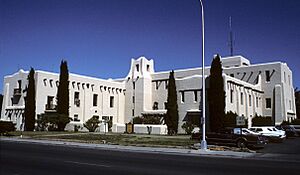
The Las Cruces Symphony Orchestra has 80 members. It includes students, university teachers, and other local musicians. They perform at the NMSU Music Center Recital Hall. The orchestra has received national attention for its performances.
Points of Interest
You can see murals painted on several water tanks in Las Cruces by artist Tony Pennock. There is also a large mural called Wave Nest on Picacho Avenue.
The Cathedral of the Immaculate Heart of Mary is an important church in the city.
Sports and Recreation
Las Cruces is home to Vado Speedway Park, a dirt track for racing.
At the university level, the New Mexico State Aggies compete in Conference USA. Their men's basketball team has been very successful, reaching the NCAA tournament many times. They even made it to the Final Four in 1970.
The Las Cruces Kings are a long-running semi-professional football team.
The Las Cruces Vaqueros were the city's first professional sports team. They played baseball in the Pecos League.
Parks and Fun Activities
Las Cruces has 87 city parks, 18 tennis courts, and four golf courses. You can find maps and details about the parks online.
The city also hosts a Ciclovía event every month. This event encourages exercise and physical activities throughout the city.
The New Mexico Farm and Ranch Heritage Museum is a large museum that shows the 3,000-year history of farming and ranching in New Mexico.
Education in Las Cruces
Public Schools
Public schools in Las Cruces are part of the Las Cruces Public School District. This district covers Las Cruces, White Sands Missile Range, Doña Ana, and Mesilla. There are 26 elementary schools, nine middle schools, and six high schools. Rio Grande Preparatory is an alternative high school.
There are also four charter schools in the district. Alma d'arte is a high school focused on arts. Las Montañas helps students who might be struggling. New America High School helps adults get their diploma or GED. Academia Dolores Huerta Middle School has a special dual language program.
The New Mexico School for the Deaf has a preschool in Las Cruces.
High Schools
- Arrowhead Park Early College High School
- Centennial High School
- Las Cruces High School
- Mayfield High School
- Organ Mountain High School
- Alma d'arte Charter High School
Private Schools
Las Cruces has several private Christian schools. These include College Heights Kindergarten, Desert Springs Christian Academy, Las Cruces Catholic Schools, Mesilla Valley Christian School, and Cornerstone Christian Academy.
There is also a non-profit private school called Las Cruces Academy. It offers classes for grades K-8.
Colleges and Universities
New Mexico State University
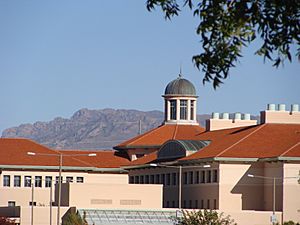
New Mexico State University (NMSU) is a major university in Las Cruces. It started in 1888 as an agricultural college. In 1960, it became New Mexico State University. In 2012, about 18,500 students attended NMSU. The university offers many programs and degrees. It is known for offering a high-quality education at a lower cost. NMSU is also a Space Grant College, meaning it works with NASA.
The Burrell College of Osteopathic Medicine (BCOM) is a private medical school on the NMSU campus. It opened in 2013.
Doña Ana Community College (DACC) is part of New Mexico State University. It opened in 1973 with 500 students. Now, it serves thousands of students each year. DACC has centers in other towns and two campuses in Las Cruces.
Libraries for Learning
The Thomas Branigan Memorial Library is the city's public library. It has about 185,000 items. The old library building, built in 1935, is now the Branigan Cultural Center.
The two university libraries at NMSU, Branson Library and Zuhl Library, are also open to the public. Anyone living in New Mexico can borrow items from these libraries.
Media and News
Las Cruces is part of the El Paso – Las Cruces media market. The city runs its own TV channel, CLC-TV cable channel 20. This channel shows city council meetings and other government and education programs. CLC-TV has won awards for its programming.
The Las Cruces Sun-News is a daily newspaper. The Las Cruces Bulletin is a weekly community newspaper. The Round Up is the student newspaper at New Mexico State University. There is also The Ink, a monthly paper about arts and events.
Las Cruces has one local public TV station, KRWG-TV, run by NMSU. It also receives TV stations from Albuquerque, El Paso, and Ciudad Juárez.
There are about ten commercial radio stations in Las Cruces. Many El Paso stations can also be heard. KRWG-FM is the local NPR station, and KRUX is a college radio station run by NMSU.
City Services and Transport
Transportation Options
Airports
- Las Cruces International Airport – This airport is used for private flights and military use. It does not have regular passenger flights anymore.
- El Paso International Airport – This is the closest airport with regular commercial flights.
Major Roads
- Interstate 10 – Goes east to El Paso, Texas, and west to Tucson, Arizona.
- Interstate 25 – Goes north to Albuquerque. Las Cruces is where Interstate 25 ends at Interstate 10.
- U.S. Route 70 – Goes northeast to Alamogordo. To the west, it joins Interstate 10.
- U.S. Route 180
Other important state roads include NM 28, NM 101, NM 185, NM 188, NM 292, NM 320, NM 373, and NM 478.
Rail Service
Las Cruces has freight train service from the BNSF Railway. Passenger train service stopped in 1968.
Bus Travel
The city has a bus system called RoadRUNNER Transit. It has eight routes and two routes for university students.
The NMDOT Park and Ride offers bus routes connecting Las Cruces to El Paso, Texas, and White Sands Missile Range.
The South Central Regional Transit District has bus lines connecting Las Cruces to Hatch and Anthony. Ztrans connects Las Cruces with Alamogordo.
Greyhound buses also serve Las Cruces, connecting it to many major cities.
Utilities and Services
The city of Las Cruces provides water, sewer, natural gas, and trash collection services. El Paso Electric provides electricity. CenturyLink provides landline phone service, and Comcast provides cable TV.
Healthcare Facilities
Hospitals in Las Cruces
- Memorial Medical Center is a large hospital with 286 beds. It offers many patient services. The University of New Mexico Cancer Center-South is also on its campus.
- MountainView Regional Medical Center is another general hospital with 168 beds. It opened in 2002.
- Mesilla Valley Hospital is a private hospital that helps people with behavioral health issues. It has 125 beds.
- Rehabilitation Hospital of Southern New Mexico helps patients recover after injuries or strokes. It has 40 beds.
- Advanced Care Hospital of Southern New Mexico is a long-term care facility with 20 beds.
Famous People from Las Cruces
Many notable people have connections to Las Cruces:
- Frank Borman: A NASA astronaut, famous for Gemini 7 and Apollo 8, lived in Las Cruces.
- Rich Beem: A professional golfer who played high school and college golf in Las Cruces.
- Randy Brown: A professional basketball player who won three NBA titles with the Chicago Bulls. He played at New Mexico State University.
- Denise Chávez: A well-known author and playwright.
- Pat Garrett: A famous Old West lawman, known for his involvement with Billy the Kid.
- Lou Henson: A basketball coach who led New Mexico State University teams to the Final Four.
- Charley Johnson: A former NFL quarterback and a professor at New Mexico State University.
- Delano Lewis: A former U.S. Ambassador to South Africa and president of National Public Radio, lives in Las Cruces.
- Mark Medoff: A Tony Award-winning playwright.
- Lenny Pickett: The saxophonist and musical director for the Saturday Night Live band, was born in Las Cruces.
- Buck Pierce: A professional Canadian football quarterback who lives in Las Cruces during the off-season.
- Clyde Tombaugh: The astronomer who discovered Pluto, lived in Las Cruces until his death.
- Austin Trout: A former world champion boxer, was born and fights out of Las Cruces.
- Fredd Young: A four-time Pro Bowl football player, played for New Mexico State and lives in Las Cruces.
Sister Cities
 Ciudad Lerdo, Durango, Mexico
Ciudad Lerdo, Durango, Mexico Nienburg, Lower Saxony, Germany
Nienburg, Lower Saxony, Germany
The Las Cruces Sister Cities Foundation helps manage relationships with these cities. The first partnership began in 1982 with Lerdo, Mexico. A second partnership started in 1993 with Nienburg, Germany. These connections help with cultural and educational exchanges.
See also
 In Spanish: Las Cruces (Nuevo México) para niños
In Spanish: Las Cruces (Nuevo México) para niños


